“Render to Caesar the things that are Caesar’s;
and to God the things that are God’s.”
We all know this phrase well that Yeshua made famous in His reply to those who were trying to catch Him off guard. Even those who haven’t read the New Testament have heard these words before and can even quote them, without even knowing who “coined the phrase.”
Watch a video introduction to this week’s study!
According to the New Testament, some Pharisees plotted together to see how they might trap Yeshua in His words. The Pharisees took some Herodians along with them as they began to execute their plan. Herodians were people who were loyal to King Herod, the Roman king of Judea. The Pharisees must have thought that they had formulated the perfect scenario to trap Yeshua, sending along Pharisees who were experts in the Law together with Herodians who were loyalists to the Roman Empire and to its emperor Caesar.
The plan was set and the scenario began to play out in this manner:
And they sent their disciples to Him, along with the Herodians, saying, “Teacher, we know that You are truthful and teach the way of God in truth, and defer to no one; for You are not partial to any. Tell us then, what do You think? Is it lawful to give a poll-tax to Caesar, or not?”
But Jesus perceived their malice, and said, “Why are you testing Me, you hypocrites? Show Me the coin used for the poll-tax.” And they brought Him a denarius. And He said to them, “Whose likeness and inscription is this?” They said to Him, “Caesar’s.” Then He said to them, “Then render to Caesar the things that are Caesar’s; and to God the things that are God’s.” And hearing this, they were amazed, and leaving Him, they went away. – Matt. 22:16-22
Rather than being trapped by the Pharisees and the Herodians, Yeshua turned their plot to condemn Him back on themselves. Yeshua answered their question without breaking the religious law and without violating the law of the Romans.
Yeshua’s response, “render to Caesar the things that are Caesar’s,” was a clear declaration that it was right to pay tax to Rome with the money that bore the image and inscription of Caesar and Rome upon it, however, what did Yeshua mean when He stated the second part of His response; and render “to God the things that are God’s?”
Since God is the Creator of the world and everything in it we could say that everything belongs to God and, therefore, we are to give everything back to Him in some capacity, however, is this what Yeshua intended? Was Yeshua referring to something specific when He differentiated between what belongs to Caesar and what belongs to God? I believe we will find the answer to these questions in this week’s Torah Portion study.
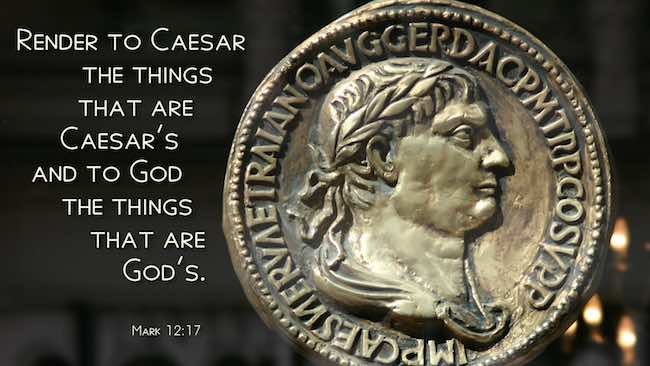
The Completion of the House of God
In this week’s study we read of the completion of the Tabernacle (Ex. 39:32-42). Every detail of the Tabernacle was finished and the Israelites brought the completed work to Moses:
And Moses examined all the work and behold, they had done it; just as the LORD had commanded, this they had done. So Moses blessed them. – Ex. 39:43
The Tabernacle was the first building project that the Israelites were involved in since leaving the Land of Egypt, the land of slavery. Instead of being forced to construct buildings for a cruel oppressor, they were now given the opportunity to freely participate in the construction of the Tabernacle of God. The people joyfully gave the materials for the project and donated their time to complete every detail. Moses approved of their work and he blessed the people.
The Priestly Garments
Another important aspect of the Tabernacle project was making clothes for the priests (i.e. for Aaron and his sons). All the garments were to be spun of certain materials and fashioned just as the LORD had commanded them to be made (Ex. 39:27-29). A separate set of clothes was made for Aaron, the high priest, including a turban which bore a special engraving:
They made the plate of the holy crown of pure gold, and inscribed it like the engravings of a signet, “Holy to the LORD.” They fastened a blue cord to it, to fasten it on the turban above, just as the LORD had commanded Moses. – Ex. 39:30-31
This unique plate of gold was attached to the turban of the high priest with a blue cord and it served as a continual reminder of the Name of the LORD, the holy standard of the LORD, and the function of the high priest to sanctify the people (Ex. 28:36-38).
The “plate of the holy crown,” which was engraved with the words “Holy to the LORD,” literally carried the name of the LORD on the forehead of the high priest. The phrase “plate of the holy crown” in Hebrew is “ציץ נזר הקודש” – “tzitzs nezer hakodesh.” The word for “holy” (קודש – kodesh) is straightforward, however, the other two words in Hebrew require a bit more explanation.
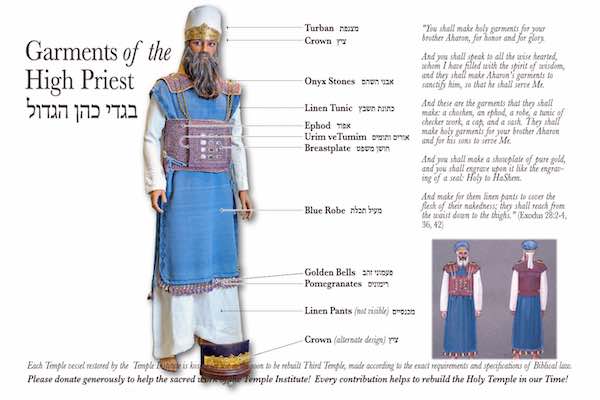
The Holy Crown
The word for “crown” used here in this verse is the Hebrew word “נזר” – “nezer,” which can mean crown but more specifically it is used for something or someone that is set apart or dedicated. The clearest example of the use of this word in the Scriptures is found in Numbers 6 regarding the Nazirite vow:
Again the LORD spoke to Moses, saying, “Speak to the sons of Israel and say to them, ‘When a man or woman makes a special vow, the vow of a Nazirite, to dedicate himself to the LORD,… – Num. 6:1-2
What you cannot see in the English translation, which is obvious in the Hebrew, is that the words “Nazirite” and “to dedicate” are the same root words. The phrase “the vow of a Nazirite, to dedicate himself to the LORD” in Hebrew is “נדר נזיר להזיר ליהוה” – “neder nazir lehazir la’Adonai.” The word “nazir” is the noun form of the verb “lehazir.” Just as a Nazirite (“nazir”) is someone who is dedicated to the LORD, so a crown (“nezer”) is a symbol of dedication.
In understanding the root meaning of the word “crown” (“נזר” – “nezer”), we can see how it is used of something or someone who is consecrated or dedicated for a specific purpose. A crown is a sign of dedication for a king over his kingdom and for the protection of the people under his rule.
In the context of Exodus 39 regarding the inscription of gold upon the forehead of the high priest, it is obviously not a “crown” in the traditional understanding but rather a sign of dedication that is fastened to the turban of the high priestly garments. This point is further clarified through a closer look at the Hebrew word used for “plate.”
The Plate of Pure Gold
The Hebrew word used for “plate” in the phrase “They made the plate of the holy crown of pure gold,” (Ex. 39:30) is the word “ציץ” – “tzitzs.” The word “ציץ” – “tzitzs” is generally used throughout the Bible to describe the majestic appearance of something that is blossoming, glowing, or beautiful in appearance.
For example this word is used to describe the “flowering blossoms” of Aaron’s staff that budded (Num. 17:8), the “flowers” that adorned the inner paneling of the Temple which Solomon built (1 Kings 6:18), and the beauty of the “flowers” of the field in the book of Isaiah (Isaiah 40:6). We also find an example of the word “ציץ” – “tzitzs” used together with the word “crown” (“נזר” – “nezer”) in the book of Psalms:
“His enemies I will clothe with shame, but upon himself his crown shall shine.” – Ps. 132:18
The phrase “his crown shall shine” in Hebrew is the phrase “יציץ נזרו” – “yatzitzs nizro.” The word “ציץ” – “tzitzs” is translated as “shine” in this verse and is used to describe the appearance of the crown.
From these various examples we see how the word “ציץ” – “tzitzs” is used to describe the majestic and attractive appearance of something. We can conclude that this “plate of pure gold” was something beautiful which adorned the turban of the high priest. Just as a flower shines forth in all of its beauty so did the plate of gold shine forth accentuating the Name of the LORD on the forehead of the high priest.
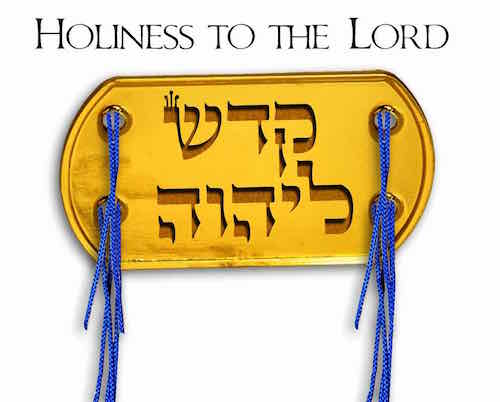
The Blue Cord
As mentioned earlier, the plate of pure gold was not a crown in the traditional sense because it is clear from the Scriptural text that the plate was fastened to the turban of the high priest:
They fastened a blue cord to it, to fasten it on the turban above, just as the LORD had commanded Moses. – Ex. 39:31
A traditional crown is set on the head of a person but this object was fastened to the turban by means of a blue cord.
The phrase “blue cord” in Hebrew is “פתיל תכלת” – “petil techelet.” The phrase “blue chord” is only used five times in all of the Old Testament:
- Twice in connection with the “plate of pure gold” (Ex. 28:37. 39:31)
- Twice in connection to the breastplate of the priest (Ex. 28:28. 39:21)
- Once in reference to the clothing of the people (Num. 15:37-38)
In the first four times that this phrase “blue cord” appears in the Bible, it is always in relation to the priesthood. In this fifth appearance, however, we see this phrase being used outside of the priesthood:
The LORD also spoke to Moses, saying, “Speak to the sons of Israel, and tell them that they shall make for themselves tassels on the corners of their garments throughout their generations, and that they shall put on the tassel of each corner a cord of blue. – Num. 15:37-38
The LORD instructed the Israelites to make a four-cornered garment with tassels (fringes) on the corners with a cord of blue placed in each tassel. We immediately see a connection between the priesthood and the people of Israel by means of the blue cord which is woven into the tassels of this four-cornered garment. What was the purpose of the blue cord in the tassels of the garment?
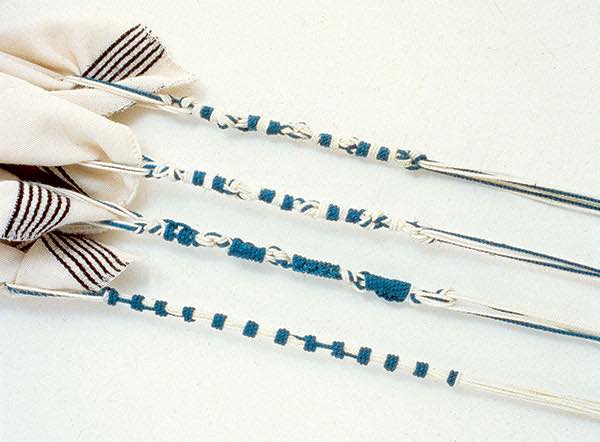
The word for “tassels” in the Hebrew is “ציצת” – “tzitzit,” which appears to be connected to the word used for the “plate” of pure gold, “ציץ” – “tzitzs.” As my friend Eleazar recently taught regarding this subject, it seems clear that the LORD was putting the inscription “Holy to the LORD,” which was on the forehead of the high priest, on each of the sons of Israel by means of the tassels (“ציצת” – “tzitzit”) of the four-cornered garment to remind them that they were to be “Holy to the LORD.”
The Gold Plate and the Tassels
The connection between the plate of gold, “Holy to the LORD,” on the forehead of the high priest to the everyday garments of the Israelites does not demand too much imagination. We read about God’s intent for the four-cornered garment with the blue cord in the following verses:
It shall be a tassel for you to look at and remember all the commandments of the LORD, so as to do them and not follow after your own heart and your own eyes, after which you played the harlot, so that you may remember to do all My commandments and be holy to your God. I am the LORD your God who brought you out from the land of Egypt to be your God; I am the LORD your God. – Num. 15:39-41
We see three clear reasons that God commanded the Israelites to wear this four-cornered garment with the tassels and the blue cord:
- To remind them to fulfill all the commandments of the LORD.
- To remind them to be holy.
- To remind them that they belong to the LORD, to the God who brought them out of Egypt.
Just as the high priest wore the gold plate (“ציץ” – “tzitzs”) which was fastened to the turban with a “blue cord” to bear the Name of the LORD, so the people of Israel were to wear a four-cornered garment with “tassels” (“ציצת” – “tzitzit”) which contained a “blue cord” in them to remind them of the holiness of God and to whom they belong.
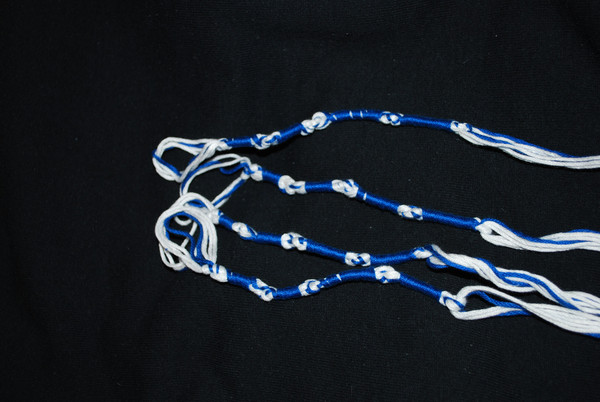
Holy to the LORD
The plate of pure gold had an inscription upon it which shone forth in all of its beauty:
They made the plate of the holy crown of pure gold, and inscribed it like the engravings of a signet, “Holy to the LORD.” – Ex. 39:30
The phrase “and inscribed it like the engravings of a signet” in Hebrew is the phrase “ויכתבו עליו מכתב פתוחי חותם” – “vayiktevu alav miktav pituchei chotam,” which is literally translated as, “they will write upon it the writing of a clear seal.” The inscription “Holy to the LORD” was to be clearly inscribed and its letters were to shine forth with pure clarity to remind all who read it of the holy God to whom they belonged.
The phrase “Holy to the LORD” – “קדוש ליהוה” – “kadosh la’Adonai” is used almost exclusively throughout the Bible as a phrase of ownership (Ex. 16:23. Lev. 27:14, 21, 23, 30, 32. Is. 23:18. Jer. 31:39. Ezek. 48:14. Zech. 14:20), meaning that if someone or something is “Holy to the LORD” than they were to be set apart for the LORD.
We see this phrase “Holy to the LORD” used in a personal way regarding the people of Israel in the book of Deuteronomy:
The LORD has today declared you to be His people, a treasured possession, as He promised you, and that you should keep all His commandments; and that He will set you high above all nations which He has made, for praise, fame, and honor; and that you shall be a consecrated people to the LORD your God, as He has spoken. – Deut. 26:18-19
The phrase “a consecrated people to the LORD” in Hebrew is “עם קדוש ליהוה” – “Am kadosh la’Adonai,” literally, “a holy people to the LORD.”
In the context of these verses in Deuteronomy, the people of Israel were chosen and set apart to be a holy people unto the LORD, however, this was not just for the sake of being a good example to the other nations of the world. God desired for the people of Israel to be His own possession, a treasured possession, who were marked as being His own.
The high priest had a clear inscription on his forehead which proclaimed the Name of the LORD. Every male of Israel also had a sign of the inscription of the Name of the LORD on his body by means of the blue cord in the tassels attached to the four-cornered garment which they were to wear. Every time that they looked at the tassels with the blue cord they would remember the commandments of the LORD, the Name of the LORD, and that they were a people who belong to a holy God. Orthodox Jews still wear this four-cornered garment today.
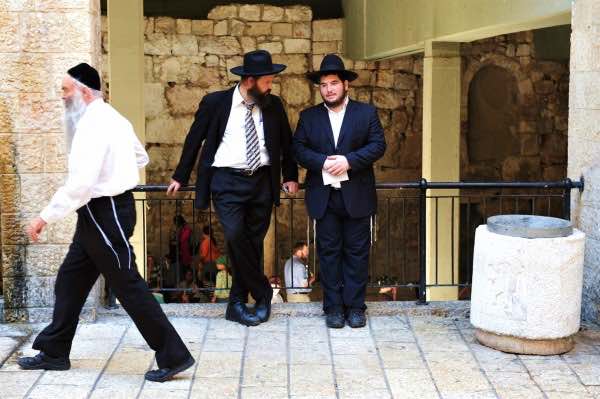
Render to Caesar…and to God
When Yeshua responded to the Pharisees and to the Herodians with the reply, “Then render to Caesar the things that are Caesar’s; and to God the things that are God’s” (Matt. 22:21), I believe that He was answering the Herodians regarding paying the tax with the coin which carried the image and inscription of Caesar and He was answering the Pharisees regarding the image and inscription that was on them. Every human being is created in the image of God (Gen.1:27) and the four-cornered garment which they wore displaying tassels with a blue cord was upon their body to remind them that they carried the name (inscription) of the LORD on their very being.
The Pharisees had forgotten to whom they belonged and had become confused with worldly thinking. Yeshua was reminding the Pharisees that the four-cornered garment which they wore bore the inscription of the LORD and they were to remember to whom they belong.
We also must remember to whom we belong and live our lives in light of the God whom we serve. In the New Testament we read how God puts His mark on us today by means of His Holy Spirit:
Or do you not know that your body is a temple of the Holy Spirit who is in you, whom you have from God, and that you are not your own? For you have been bought with a price: therefore glorify God in your body. – 1 Corinthians 6:19-20
Just as the LORD redeemed the Israelites from Egypt and made them His own people, so has the LORD God bought each of us today by the sacrifice of Yeshua and we now belong to Him. If we believe in Yeshua, our bodies have become the temple of the Holy Spirit. Our bodies belong to the LORD, therefore, let us glorify God in our bodies.
Shabbat Shalom!
If you enjoyed reading this article, we invite you to sign up for our weekly Torah Portion commentary on the sidebar to the right.
We also invite you to partner with us by giving a donation of any amount. Click here to donate today: 
Torah Portion: Ex. 38:21 – Ex. 40:38
Hafatara: 1 Kings 7:51 – 1 Kings 8:21
Copyright Jewels of Judaism – All rights reserved 2017


THANK YOU SO MUCH FOR THIS WONDERFUL TEACHING!
I wish your teaching could be available in Hebrew!